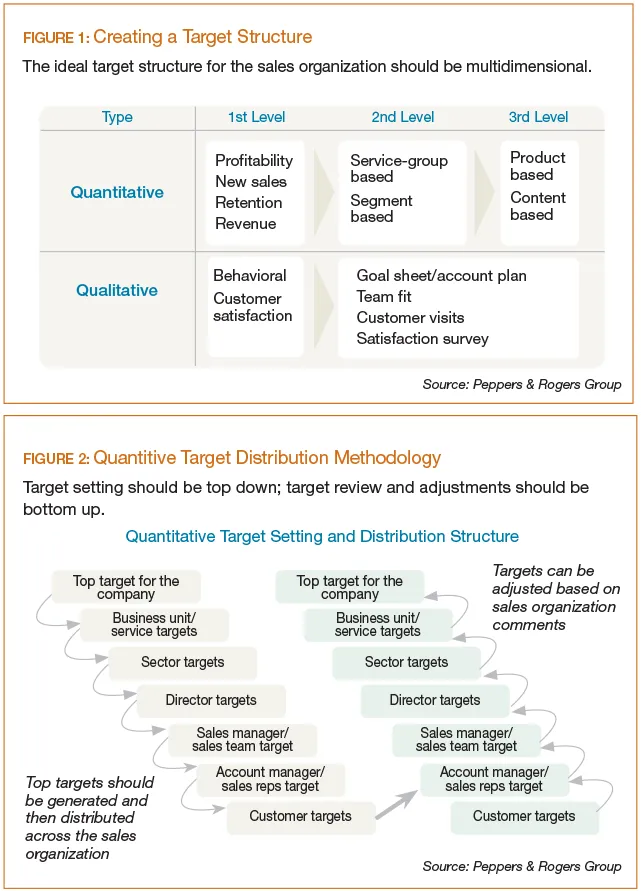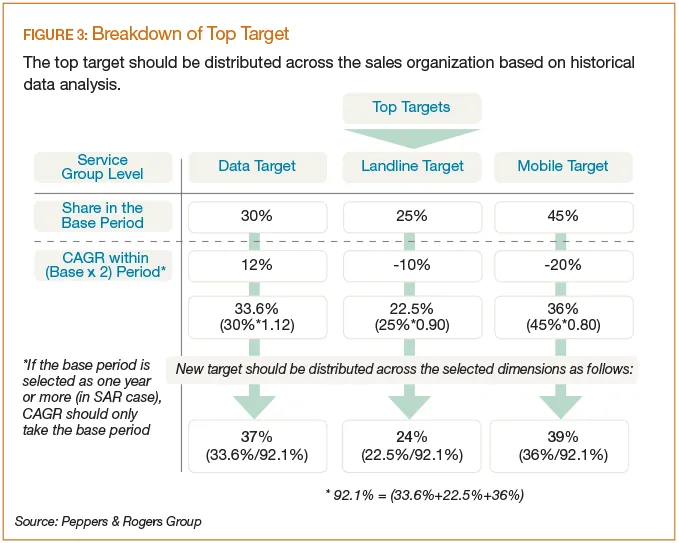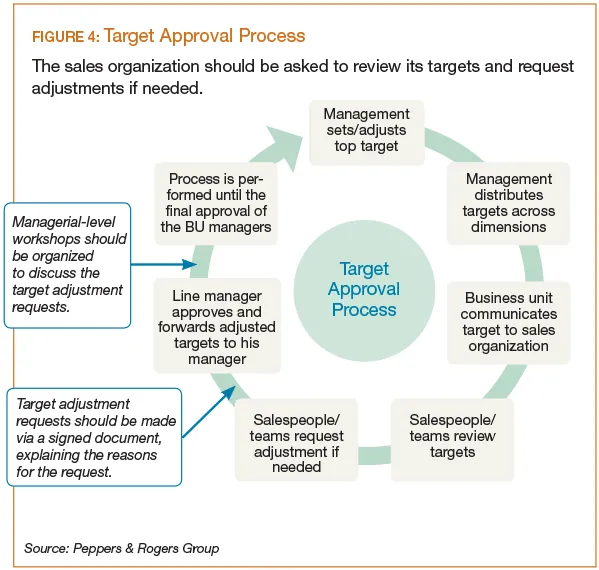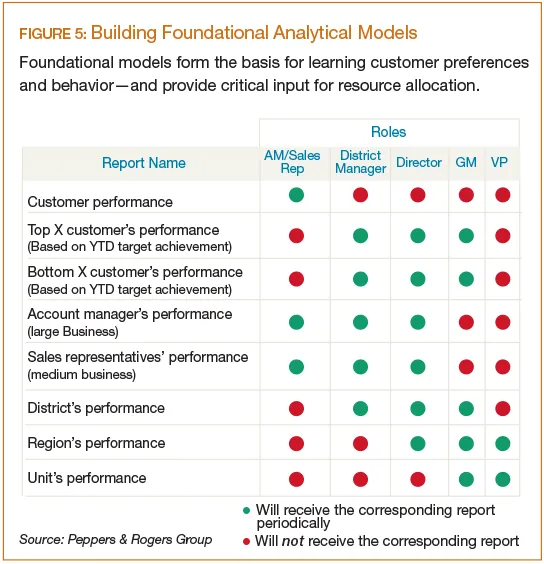Quotas are effective motivators, but the true value in setting sales targets is that it forces the company to look at the future objectively. A sales target is a prediction based on past sales performance and an analysis of expected internal and external conditions, like market fluctuation. There are four steps to effecting target setting and performance tracking in enterprise sales organizations:
- Establish target definitions and analyze data
- Set specific targets for the enterprise sales organization
- Distribute targets to the sales organization
- Track targets and performance
This approach can be applied to a wide range of sales organizations in different sectors with slight modifications. As an example, we'll examine target setting and performance tracking in telecom operators.
Establish target definitions and analyze data
The first step in the target-setting process includes several elements, from understanding expectations to determining target structure to collecting and analyze relevant data. Setting targets begins with determining the expectations of corporate strategy through management meetings. These meetings are critical to understanding the company's growth and retention strategies. Meetings should be conducted with the following structure to maximize their effectiveness:
- Conduct a workshop with directors to discuss factors affecting sales performance;
- Hold one-on-one meetings with business unit heads to review each unit's growth and retention strategy;
- Have a one-on-one meeting with the head of the enterprise business unit to examine the overall corporate growth and retention strategy.
- Use the input from these meetings as discussion topics in higher-level management meetings to set the final strategy.
Once there is an understanding of the firm's growth and retention strategies, the next action is to define a multidimensional target structure for the sales organization.organization. The ideal target structure should include all the critical dimensions—e.g., qualitative/quantitative, revenue/ profit, group/product-based—and the total target should be controlled by a weighted average system to achieve maximum flexibility (see Figure 1).
It's important to consider the enterprise sales organization in two main parts when building a target structure: 1) account managers (AM) who build and maintain relationship with customers. AMs have customers assigned to them; 2) sales account representatives (SAR) who serve walk-in customers in business outlets like retail stores. SARs can have their customer portfolios consist of small and medium-size customers.

The target structure for the AM role should include both quantitative and qualitative elements. It should mainly be profit or revenue based, as well as customer based, since there is a one-to-one relationship with customers. And it should include service-group targets, such as data group services, landline group services, or mobile group services. Conversely, the target structure for the SAR role should mainly be new-sales and product based since there is not a one-to-one relationship with customers. However, it should also include service-group targets.
Defining the target-carrying roles in the organization is a crucial step, since most sales organizations associate targets with compensation plans. Therefore, it's essential to create differentiation by roles in the target structure to eliminate disputes. Personnel who carry sales targets include AMs and SARs; they directly contribute to sales and revenue earning. Personnel who carry qualitative targets include support roles that contribute to service maintenance, customer experience, and the like. These roles in most enterprise telecom sales organizations are within the reporting function, planning and performance, help desk group, and customer care group. It is recommended to scope the project around roles that carry sales targets, since supportive roles in most sales organizations can vary greatly and can also have complicated KPIs.
Collecting internal and external historical data, as well as analyzing the data and choosing a base period for target calculation, completes the first of the four main steps in the target-setting process. Ideally, every possible combination of quantitative targets should be listed and then historical data should be analyzed to uncover any patterns. Focus areas of the analysis could include seasonality in target dimensions, sector-based revenue fluctuations, profitability/ revenue CAGR for products or segments, customer churn trends, trends for new products, and the effects of billing cycles.
Once the data have been analyzed, the next action is to define a base period to predict the sales target for the next year. This is often referred to as the retention target. The base period shouldn't be too lengthy because sales personnel can only be responsible for generating sales from their specific customers. For example, if the base period is one year, 10 times the revenue will be carried to next year; AMs will have trouble achieving this goal because their pipeline of prospects may not support the target. A base period of two to four months will provide a more logical perspective. Monthly average revenue for the past three months can be normalized to a year and this value can be set as the base sales target for the following year.
Set specific targets for the enterprise sales organization
Setting targets should have two main phases: Target setting should be top down; target review and adjustments should be bottom up (see Figure 2). When setting targets, management should begin with the company's target, and then narrow the targets for business units, sectors, directors, sales teams, and individual sales reps. Target setting should also include setting targets for specific customers. When reviewing targets and making adjustments the process should be reversed, starting with customer targets and targets for individual salespeople. It should then move up through teams, units, and the overall organization.
It is necessary to calculate the effect of internal and external factors for each segment/ sector when creating targets. Internal considerations include such issues as workforce size, price changes, working capital shortage, new products, and motivation plans. External concerns include the competition, the economy, political changes, and population. Additionally, management must consider the impact of the corporate strategy and potential market growth when calculating the organization's sales target. Targets should include both quantitative and qualitative sales targets.
The value of setting qualitative targets for the sales functions lies in their potential financial impact. Behavioral targets and customer satisfaction targets, for example, will have an indirect impact on company profitability and on generated revenue. Consequently, qualitative targets should be measurable through systems. For example, can account managers enter their customer visits into the system? Is there an approval mechanism? Addtionally, the organization needs a standardized way to measure customer satisfaction like a survey that produces a specific score based on criteria that deliver business impact.
Distribute targets to the sales organization
Once management has created specific targets for the sales organization, it must break down the overall target into organizational levels and across time periods. This means multilevel distribution—sector/segment, regional, sales team, individual, customer—over set time periods, e.g., yearly, quarterly, monthly.
The top target should then be distributed across the sales organization based on the findings from historical data analysis. In telecom, for example, a top target might break down into three sub-targets: data, landline, and mobile (see Figure 3). Each sub-target would have a share of the total within the base period.

Management must clearly communicate these targets across the organization, as well as to the sales team. One way to do so is to conduct workshops with the sales organization. During the process, the sales organization should be asked to review its targets and request adjustments, if needed. The company should adopt a target approval process to formalize the review and adjust any targets (see Figure 4). As part of that process sales managers should request target adjustments via a signed document, explaining the reasons for the request. Then management should organize executive-level workshops to discuss the target adjustment requests.
Track targets and performance
The target-setting process is not complete without performance tracking. This should include defining target tracking periods, creating performance scorecards for the sales team based on both quantitative and qualitative targets, updating any supporting systems, and defining potential target adjustment scenarios, criteria, and periods.

Sales management should begin by defining a list of fields necessary to track the performance of the sales organization. Fields could include, for example, total prior year target, year-to-date retention target, and actual revenue growth. In the case of telecommunications, the sales organization might track the previous year growth targets for data, landline, and mobile, as well as the retention targets across those three areas. The ideal approach should generate common metrics that the whole sales organization can use. Basic sales reports should use the same metrics to calculate performance for each group tracking their own targets.
Ideally, the organization should use a reporting tool to track performance and adjust targets. The system should generate different levels of reports based on a user's level in the organization, as well as on the defined metrics. So a division manager would receive a different report than an account manager (see Figure 5). Additionally, sales management should monitor the key performance metrics via a dashboard. The dashboard could include such measures as revenue by channel and year-to-date sales by product. A telecom company might track active subscribers by channel, number of services per subscriber,or sales across mobile, landline, and data offerings.
Changes in performance may warrant adjustments to sales targets. Other target adjustment scenarios, criteria, and time periods potentially include such areas as major economic or political changes, pricing policy changes, or change in workforce size.

The ever-moving target
Setting sales targets forces a company to look at the future objectively, which helps to more accurately predict performance. Effecting target setting and performance tracking in enterprise sales organizations includes establishing target definitions, setting specific targets for the sales team and distributing those targets, and then tracking performance. A detailed target-setting and tracking process allows an organization to create consistency within its targets, while offering flexibility to adjust targets as necessary, based on both internal and external factors. Ultimately, this will lead to an improvement in overall business results.

















